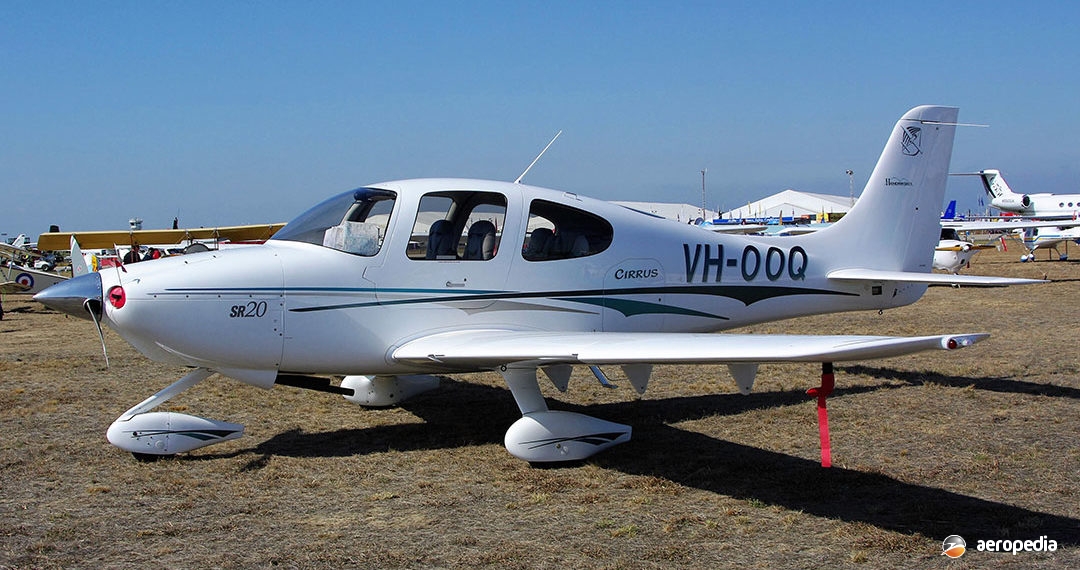Photograph:
Cirrus SR-20 VH-OOQ (c/n 1376) at Avalon, VIC (David C Eyre)
Country of origin:
United States of America
Description:
Four-seat cabin monoplane
Power Plant:
One 149 kw (200 hp) Teledyne Continental IO-360-ES six-cylinder horizontally-opposed air-cooled engine
Specifications:
- Wingspan: 10.88 m (35 ft 7 in)
- Length: 8.01 m (26 ft 3 in)
- Height: 2.83 m (9 ft 3 in)
- Wing area: 12.54 m² (135 sq ft)
- Cruising speed at 75% power at 1,981 m (6,500 ft): 296 km/h (184 mph)
- Rate of climb: 305 m/min (1,000 ft/min)
- Service ceiling: 4,877 m (16,000 ft)
- Stalling speed with flaps: 100 km/h (62 mph)
- Range with 45 mins reserve: 1,482 km (921 miles)
- Empty weight: 816 kg (1,800 lb)
- Loaded weight: 1,315 kg (2,900 lb)
History:
The Cirrus SR-20 was developed by the Cirrus Design Corporation in Minnesota and was a low-wing all-composite design with a fixed undercarriage, seating four, with a 149 kw (200 hp) Teledyne Continental IO-360-ES engine, which has been manufactured at the Company’s facility at Grand Forks, North Dakota.
Two prototypes or proof-of-concept aircraft were built, the first flown on 31 March 1995, being registered N200SR, and the second N202CD, being flown in November 1995, the type certificate being obtained in 1998. The Company stated by late 1997 it had orders for 132 aircraft and had the intention of eventually building up to 400 aircraft per year.
Cirrus Design Corporation, prior to the introduction of the SR-20, produced the VK-30 in 1987 in kit form, this being a five-seat high-performance aircraft with a rear mounted engine driving a propeller behind the tail, fitted with engines in the 209 kw to 261 kw (280 hp to 350 hp) range; but in the event the design was considered to be too complex for amateur construction and so the SR-20 was developed.
The SR-20 was of composite construction with upturned wingtips, mid-set tailplane with horn-balanced elevators, horn-balanced rudder and dual controls. It was also the first aircraft fitted with Cirrus Airframe Parachute System (CAPS), a certified ballistic parachute, as standard equipment installed aft of the baggage compartment which, in the event the aircraft got into problems, deployed and lowered the aircraft to the ground.
The SR-20 was initially made available with standard analogue instruments and an Avidyne FlightMax multi-function display unit but in 2003 the Avidyne Entegra primary flight display system was made available as an option, and later that year the full glass cockpit became standard on all models.
First of the type seen in this region arrived late in 1998, becoming VH-CRF (c/n 1033), and since then a number of examples have been imported.
In 2000 Cirrus released a new model, the SR-22, first shown to the US Aircraft Owners and Pilots Association (AOPA) meeting in Florida. This model was slightly larger and was powered by a 231 kw (310 hp) Teledyne Continental IO-550-N engine. It had a cruising speed at 75 per cent power at 2,438 m (8,000 ft) of 333 km/h (207 mph).
Production of both models has continued, 125 examples of the Cirrus SR-20 being delivered in 2005.
One Cirrus SR-20 N205CD (c/n 1002) was donated to the Museum of Flight in Seattle in Washington State and placed on permanent display.

